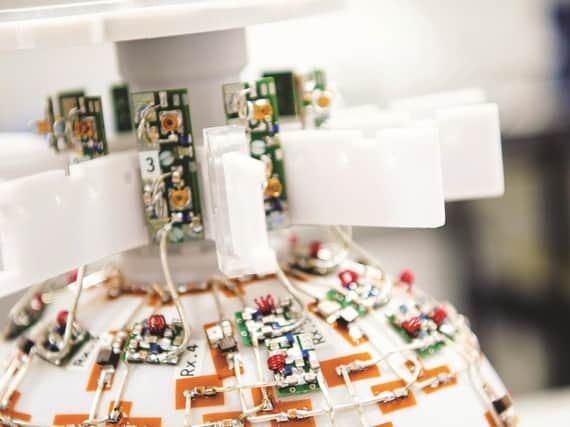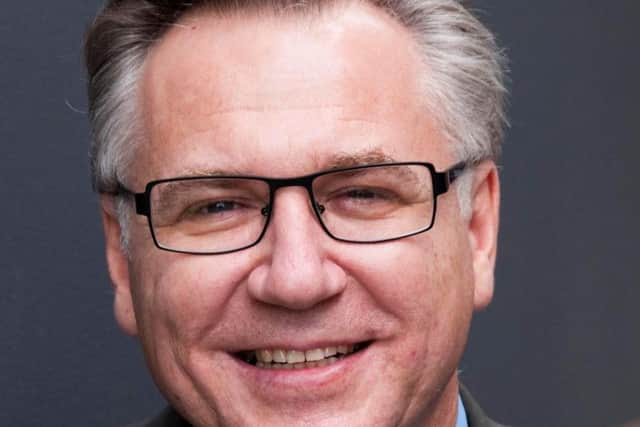Will Scottish scientists crack the code to diagnosing medical problems before they develop?


Everyone talks about collaboration in life sciences, but when does it become real? When do those connections start to have a genuine and positive impact on individual lives and human health?
In Glasgow, it’s happening. The Triple Helix is taking shape; clinicians, businesses and academics are working together in a practical, co-operative way to make a real difference.
It’s a complex story, still in its early chapters, with many actors. However, let’s start with the Living Laboratory being developed at the Queen Elizabeth University Hospital (QEUH) in Govan.


Professor Dame Anna Dominiczak of the University of Glasgow explains: “At this huge hospital, we have a Clinical Innovation Zone where the NHS, the university and industry are all co-located alongside the Stratified Medicine Scotland Innovation Centre. The university carries out research, the NHS needs to do clinical trials and industry needs, for example, tissue samples and data.
“This opens up the opportunity to collaborate and to carry out really sophisticated clinical trials to the benefit of patients. The Living Laboratory is a place to start implementing Precision Medicine because the whole is greater than the sum of the parts.”
Dominiczak uses the example of Glasgow-based ThermoFisher Scientific, which has developed a chip with DNA markers to examine the potential for patients receiving a number of different drugs to have adverse reactions to one or more of those drugs. This is called pharmacogenetics – the study of inherited genetic differences in drug metabolic pathways.
“The company can test this in a real situation, working with clinicians at QEUH to deliver significant and relevant results,” says Dominiczak, the university’s Regius Professor of Medicine.
And the benefits? “If we predict effectively who will get adverse reactions, we can treat them more effectively – and more cost-effectively for the NHS – by stopping prescribing endless medication that is not working.”
Dominiczak often describes this Precision Medicine (or “stratified medicine”) approach as the antidote to “old, trial and error medicine”. She explains: “We used to think high blood pressure was one disease. You diagnose it, you give the patient a drug and if it doesn’t work, you try another drug. Now we have great imaging and great molecular knowledge – and rather than just using this knowledge for research, it is now travelling to patients. We put all that together with all the normal measures – blood pressure, heart rate, blood count, etc – and using the stratified model, select much more targeted, effective treatments.”
The next step, says Dominiczak, is to use this sophisticated analysis for pre-symptomatic diagnosis – identifying a problem before it has developed. “That’s the Holy Grail and that’s where modern medicine is going,” she says. “If you can delay the onset of really severe debilitating conditions or disease – heart failure, diabetes or cancer, for example – you have a healthier and more economically active population and can save on drug bills and hospital admissions.
“We do not know how much we can change the natural history of a disease, or exactly how our early and very sophisticated interventions can help. But we can already see better survival rates for some cancers and successes in clinical trials.”
Dominiczak thinks the location of the Living Laboratory, in Govan, is highly significant: “We are bringing the most modern technology and the best brains to where they are most needed. If you look at maps showing the highest incidence of heart disease and cancer, for example, Glasgow is right up there. Rates in Oxford and Cambridge are very, very low, but they still want the research money.
“This kind of work should be done where disease is rampant, where we can do most good in the quickest time – and Glasgow is a good example.”
Dominiczak says the work going on at the University of Glasgow as part of the collaboration is far removed from traditional academic research: “We have embedded what we do in the NHS, inside a hospital.
“We are delivering for patients in Glasgow and providing jobs and economic growth. This is not ivory tower research, it’s real-life research with social and economic impact.”
This will develop further as the university builds an Institute of Health and Wellbeing at its Gilmorehill campus as part of a £1 billion investment over the next decade. This will help create an ‘innovation district’, linking the new Institute through to QEUH’s Clinical Innovation Zone and Living Laboratory. Around 3,000 jobs are due to be created by the project and Glasgow City Council has grasped the wider economic and social impact of the hub. It has already supported the University’s Imaging Centre of Excellence (ICE) at the QEUH with £16 million through the Glasgow City Deal.
Dominiczak sees the advanced high-quality imaging provided by ICE as crucial to delivering precision medicine and tackling chronic disease in Glasgow. The ICE project has also helped to cement the relationship between the university, NHS and private business. German company MR Coiltech, which developed coils for the UK’s first clinical 7T (7 Tesla) MRI scanner at the ICE, relocated to the Clinical Innovation Zone and is now serving the global market from Glasgow.
Yet during a time of dizzying technological progress, it is also crucial to retain and understand the value of 1:1 human relationships, Dominiczak believes. She says: “At a recent event, I was asked if we replace everything with artificial intelligence and machine learning, would we lose that patient-doctor contact? We need to explain to people that this revolution is not taking away patient-doctor contact, it is helping to make it better and more efficacious.”
This technological revolution includes sharing data from similar clinical trials in different parts of the world, which can help benefit patients globally.
“What we are trying to achieve is to give patients, wherever they live in the world, the best possible treatment, irrespective of financial means. That is very attractive to me,” says Dominiczak.
Tackling pancreatic cancer
When demands for health interventions are so huge, across a wide range of diseases and conditions, how is it possible to decide on priorities? “There are many factors,” says Professor Dame Anna Dominiczak. “We need the primary funding before we can start on the projects.
“However, if we look at something like pancreatic cancer, average survival rates are still only six months from diagnosis, despite 20 years of research. We recruited Professor Andrew Biankin – a world expert in pancreatic cancer – from Australia, and he brought knowledge, contacts and advanced networks in this particular area.
“The Glasgow infrastructure was perfect for him to bring his specialist knowledge and he now has a laboratory where he does very advanced DNA sequencing to sub-stratify pancreatic cancer and select the best possible treatments for these patients.
“He has attracted a wide range of funding from Scottish, UK and international sources and his research is discussed widely at meetings around the world – and Glasgow and patients here are benefiting from his work. This is a good example of how we add value to patients reasonably quickly. He says he was not able to deliver precision medicine in the private sector in Australia, but that he has been able to do it in the public sector in Glasgow.”
The perfect base
When it comes to selling the Glasgow life sciences cluster to the world, BioClavis is the poster boy (or girl).
The personalised diagnostics business, a spin-out from US-based BioSpyder Technologies, selected Glasgow as its base after a global search.
“They looked all over the world and both the hospital and the Clinical Innovation Zone were hugely attractive. It allowed them to become embedded in a large acute hospital with access to clinicians, data and tissue samples, letting them work on gene expression on a large scale,” says Professor Dominiczak.
BioClavis, supported by a £4.5 million R&D grant from Scottish Enterprise, created 43 jobs on arrival in Glasgow. “BioClavis is a very youthful, vibrant business and has almost doubled in size already,” says Dominiczak.
Joel McComb, chief executive of BioSpyder and BioClavis, said when the firm’s arrival in Glasgow was announced in October 2017: “We determined Glasgow to be the ideal location for this initiative based in large part on the support and close working relationships with Scottish Enterprise, NHS and the University.”
For more information, click here